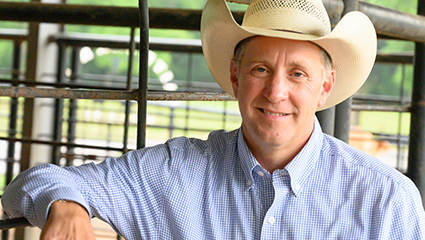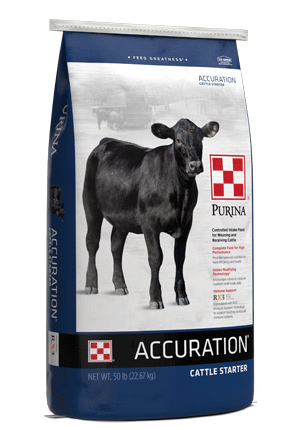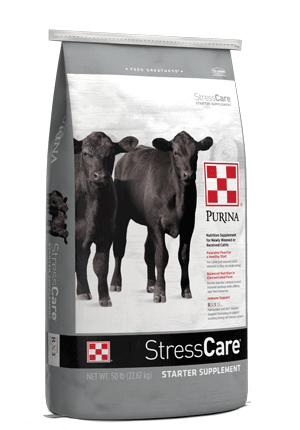
Retained Ownership in the Feedlot: Three Considerations
Management : Weaned Calf
Management : Grower & Finisher
Nutrition : Supplements
Retained ownership can pay off at the feedlot, but a thoughtful plan must be in place.
Owning cattle all the way to the packer might sound like a scary proposition. The risk of the cattle market falling while feeding cattle to a finished weight can be hard to bear. However, the potential to capitalize on a herd’s genetic improvements, along with investments in health and nutrition, could outweigh the risk.
If you’re buying quality bulls, developing home-raised replacement heifers and building a strong genetic base, there is certainly an incentive to retain ownership of calves. Selection for traits like growth, feed efficiency and marbling adds up to a total genetics package that can pay off.
If you have the kind of cattle that can perform in the feedlot and on the rail, make these considerations.
Based on your breakeven analysis, if there is an opportunity to make more profit than your traditional marketing plans, you should seriously consider retained ownership. Each year is different. Sometimes it might work better to sell calves at weaning and other years the markets may be more favorable to hold calves to a higher weight.
Depending on when you wean calves, market seasonality could come into play, allowing you to decide later. We can economically add weight to calves and potentially feed into a better market by keeping those calves at home for a bit longer.
Once calves move from a weaned market weight into a higher feeder weight, you can determine if calves should move to a feedlot or not.
The easiest way to locate a feeding partner is by word-of-mouth recommendations. Talking to other cattle producers in your network who have retained ownership will not only help you learn more about the process, it can help identify the right feedlot to partner with.
You may also find feedlot partners by networking at tradeshows or producer events, or simply by searching the internet and browsing feedlot websites or social media pages.
Once you identify a feedlot, don’t be afraid to ask questions like:
When weaning calves, use Purina® Stress Tubs to supply the right balance of trace minerals during the stressful weaning phase.
Starter feed options include:
Calves fed RX3® Immune Support Technology also have lower incidence of sickness with 6.8% average morbidity rate, compared to 13.6% for non-RX3® fed calves.1
Using any of these three Purina® starter feeds with RX3® Immune Support Technology can help prime a calf’s immune system.
Not only are you setting calves up for success at home with RX3® Immune Support Technology. You’re also securing their health at the feedlot and protecting the money invested in retaining ownership.
Does your cattle nutrition program stack up? Find out with a Proof Pays trial.
1 Summary of Purina studies CG131, CG153, CG165 CG171 and PMI studies at University of Minnesota and North Dakota State University
Owning cattle all the way to the packer might sound like a scary proposition. The risk of the cattle market falling while feeding cattle to a finished weight can be hard to bear. However, the potential to capitalize on a herd’s genetic improvements, along with investments in health and nutrition, could outweigh the risk.
If you’re buying quality bulls, developing home-raised replacement heifers and building a strong genetic base, there is certainly an incentive to retain ownership of calves. Selection for traits like growth, feed efficiency and marbling adds up to a total genetics package that can pay off.
If you have the kind of cattle that can perform in the feedlot and on the rail, make these considerations.
1. Know the market
Making the leap to retain ownership takes planning – some years, you might have to wait longer to get paid for calves than you normally would. Looking at breakeven prices is a must, consider doing it when you are weaning calves.Based on your breakeven analysis, if there is an opportunity to make more profit than your traditional marketing plans, you should seriously consider retained ownership. Each year is different. Sometimes it might work better to sell calves at weaning and other years the markets may be more favorable to hold calves to a higher weight.
Depending on when you wean calves, market seasonality could come into play, allowing you to decide later. We can economically add weight to calves and potentially feed into a better market by keeping those calves at home for a bit longer.
Once calves move from a weaned market weight into a higher feeder weight, you can determine if calves should move to a feedlot or not.
2. Find a feedlot partner
Finding a feedlot to care for your calves is a major deciding factor for retaining ownership.The easiest way to locate a feeding partner is by word-of-mouth recommendations. Talking to other cattle producers in your network who have retained ownership will not only help you learn more about the process, it can help identify the right feedlot to partner with.
You may also find feedlot partners by networking at tradeshows or producer events, or simply by searching the internet and browsing feedlot websites or social media pages.
Once you identify a feedlot, don’t be afraid to ask questions like:
- How will payment work for yardage and feed costs?
- Are financing options available to help cover the up-front costs?
- Can we partner on cattle ownership to help split up costs?
- Should I sell my cattle on a grid, formula or the live cattle cash market?
- Is hedging cattle an option to help protect the profit on calves?
- How much data can I get back on feeding performance and beef quality?
3. Prepare calves for the feedlot
It is always essential to have your calves ready to move onto another phase, whether you retain ownership or not. Weaning calves for 45 days on the home farm or ranch can help minimize stress and maintain immune status.When weaning calves, use Purina® Stress Tubs to supply the right balance of trace minerals during the stressful weaning phase.
Starter feed options include:
- Purina® Stress Care® 5 Supplement: Fed in bunks and supplemented with forage
- Purina® Precon® Complete: Fed in bunks, may require supplemental forage depending on what amount is fed
- Purina® Accuration® Starter: Fed in self-fed bulk feeders, no supplemental forage needed
Calves fed RX3® Immune Support Technology also have lower incidence of sickness with 6.8% average morbidity rate, compared to 13.6% for non-RX3® fed calves.1
Using any of these three Purina® starter feeds with RX3® Immune Support Technology can help prime a calf’s immune system.
Not only are you setting calves up for success at home with RX3® Immune Support Technology. You’re also securing their health at the feedlot and protecting the money invested in retaining ownership.
Does your cattle nutrition program stack up? Find out with a Proof Pays trial.
1 Summary of Purina studies CG131, CG153, CG165 CG171 and PMI studies at University of Minnesota and North Dakota State University



